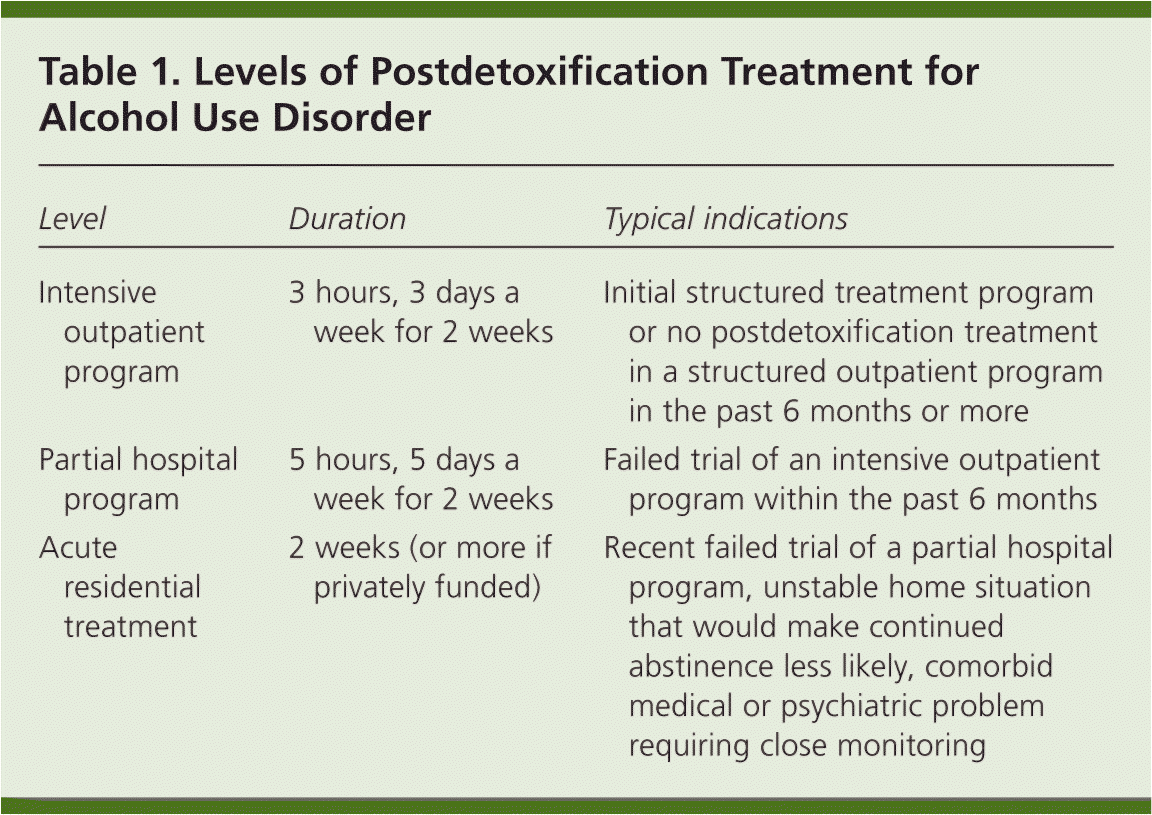
Am Fam Physician. 2013;88(9):576
Related article: Outpatient Management of Alcohol Withdrawal Syndrome.
Author disclosure: No relevant financial affiliation.
The media have profiled the damaging impact alcohol use disorders can have on patients' lives. The portrayal of treatment, however, is often unrealistic: patients are whisked away to exclusive treatment centers and are immersed in 90-day programs. Such centers are beyond the reach of most patients hoping to use their health insurance to pay for treatment. As a result, patients, their families, and sometimes their physicians do not know what treatment for alcohol use disorders looks like.
In our inpatient detoxification unit, we tell patients that detoxification is just “the tip of the iceberg,” and that the postdischarge treatment program is key in determining whether they will abstain from alcohol.
Treatment programs differ from state to state. A reasonable approximation of the levels of care after alcohol detoxification is presented in Table 1. After initial treatment for alcohol withdrawal syndrome, most patients are referred to an intensive outpatient program for a concentrated continuation of the concepts often introduced during the inpatient detoxification program. The intensive outpatient program (IOP) consists of group and individual counseling with biochemical verification of abstinence. Group counseling can consist of formal group psychotherapy or self-help groups, such as Alcoholics Anonymous or SMART (Self-Management and Recovery Training). Patients who cannot maintain abstinence at the IOP level of care may be referred to a partial hospital program that includes longer duration of daily treatment than in outpatient treatment. Acute residential treatment, or inpatient rehabilitation, is required when lower levels of care are insufficient, typically because of a high-risk home environment or a comorbid medical or psychiatric condition that requires close monitoring.1 Although health insurance rarely covers more than two weeks of acute residential treatment, it can be extended with private financial resources if available.

| Level | Duration | Typical indications |
|---|---|---|
| Intensive outpatient program | 3 hours, 3 days a week for 2 weeks | Initial structured treatment program or no postdetoxification treatment in a structured outpatient program in the past 6 months or more |
| Partial hospital program | 5 hours, 5 days a week for 2 weeks | Failed trial of an intensive outpatient program within the past 6 months |
| Acute residential treatment | 2 weeks (or more if privately funded) | Recent failed trial of a partial hospital program, unstable home situation that would make continued abstinence less likely, comorbid medical or psychiatric problem requiring close monitoring |
If abstinence is maintained during the first month, the treatment plan should consist of, at minimum, individual and/or group counseling and self-help groups. Pharmacotherapy (e.g., disulfiram [Antabuse], naltrexone [Revia], acamprosate [Campral]) is added when appropriate, and the patient may consider sober living environments, such as a transitional living program or sober house. A strong support network of clinicians, family, and friends increases the chance that signs or symptoms pointing to relapse are recognized early and that a higher level of care is sought if necessary.
Significant barriers to treatment remain. Patients may be ambivalent about committing to a structured aftercare program, citing past failures with similar programs or the need to get back to work. The treatment team should try to help patients recognize the need for postdetoxification treatment before they sustain more losses from their alcohol use. It may take multiple attempts to establish abstinence from alcohol. Although postdetoxification treatment programs that are available for most patients are not as glamorous as those sometimes portrayed in the media, they can be effective when used appropriately.
